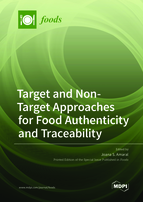Target and Non-Target Approaches for Food Authenticity and Traceability
A special issue of Foods (ISSN 2304-8158). This special issue belongs to the section "Food Engineering and Technology".
Deadline for manuscript submissions: closed (30 September 2020) | Viewed by 74287
Special Issue Editor
Interests: food authenticity; food chemistry; molecular biology approaches applied to food authentication and GMO detection; plant food supplements; bioactive compounds; antioxidant activity; antimicrobial activity; chromatography; development of analytical methods
Special Issues, Collections and Topics in MDPI journals
Special Issue Information
Dear Colleagues,
As a result of food scandals that drew worldwide attention, there has been increasing demand for transparency in the food industry, enforcement of legislation and proper labelling of foods. Food supply chains are becoming increasingly globalized and complex, contributing to a growing problem of food fraud. In addition, there has been a growing demand for gourmet and traditional food products, which are sold at higher prices, making premium products prone to adulteration for economic gain. In this context, food authenticity and traceability are becoming important to avoid unfair competition among producers and protect consumers. To address the referred problems, several analytical methodologies have been proposed in recent years, including both target and non-target approaches.
Given the above, we invite researchers to submit unpublished original manuscripts and review papers on food authenticity and traceability to be included in a Special Issue of Foods. The subjects covered by this issue include, but are not limited to
- Analytical tools for the authentication of foods, including target and non-target approaches;
- Assessment of the geographical origin of foods;
- Assessment of the species of origin of foods;
- Chemical fingerprinting of foods;
- Chemometrics for the authentication of foods;
- DNA markers for the authentication of foods;
- Traceability in the food chain.
Prof. Dr. Joana S. Amaral
Guest Editor
Manuscript Submission Information
Manuscripts should be submitted online at www.mdpi.com by registering and logging in to this website. Once you are registered, click here to go to the submission form. Manuscripts can be submitted until the deadline. All submissions that pass pre-check are peer-reviewed. Accepted papers will be published continuously in the journal (as soon as accepted) and will be listed together on the special issue website. Research articles, review articles as well as short communications are invited. For planned papers, a title and short abstract (about 100 words) can be sent to the Editorial Office for announcement on this website.
Submitted manuscripts should not have been published previously, nor be under consideration for publication elsewhere (except conference proceedings papers). All manuscripts are thoroughly refereed through a single-blind peer-review process. A guide for authors and other relevant information for submission of manuscripts is available on the Instructions for Authors page. Foods is an international peer-reviewed open access semimonthly journal published by MDPI.
Please visit the Instructions for Authors page before submitting a manuscript. The Article Processing Charge (APC) for publication in this open access journal is 2900 CHF (Swiss Francs). Submitted papers should be well formatted and use good English. Authors may use MDPI's English editing service prior to publication or during author revisions.
Keywords
- food integrity
- traceability
- protected designation of origin
- geographical origin
- species identification
- advanced methods
- fingerprinting approaches
- chemical markers
- DNA markers







